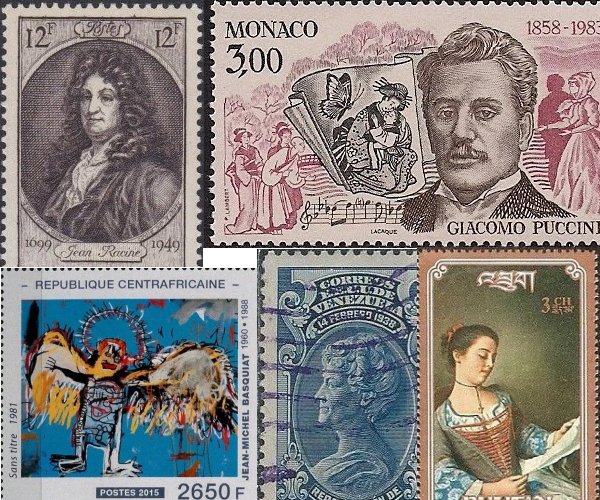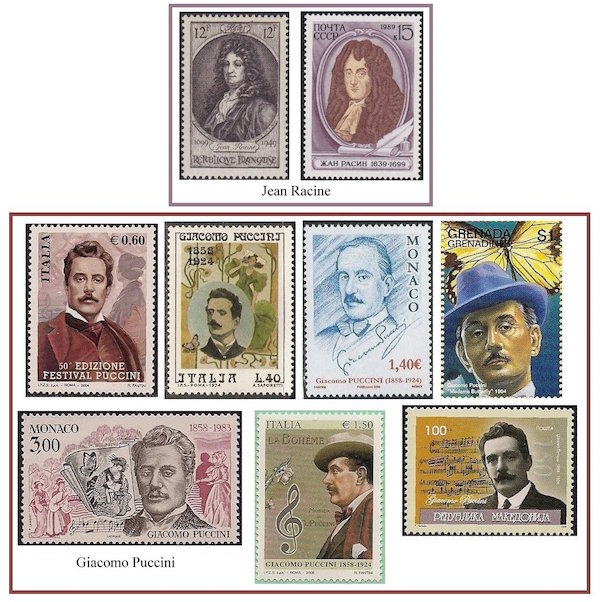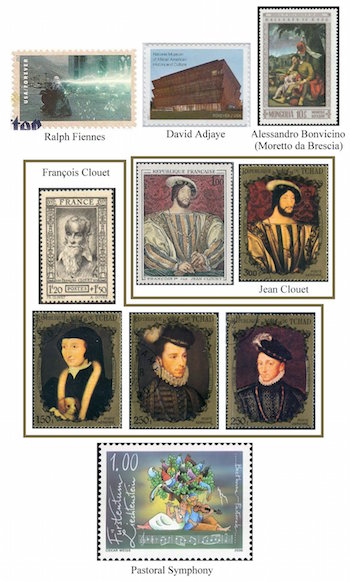The Arts on Stamps of the World — December 22
An Arts Fuse regular feature: the arts on stamps of the world.

By Doug Briscoe
Today’s three headliners are a very mixed bag indeed: French dramatist Jean Racine, Italian opera composer Giacomo Puccini, and African-American painter Jean-Michel Basquiat.
Racine (1639 – 21 April 1699) belonged to that triumvirate of great French playwrights of the age that also included Molière and Corneille. As Molière focused on comedy and Racine and Corneille on tragedy, the rivalry was keener between the latter two, although Racine earned Molière’s enmity by switching theaters after Molière had generously staged Racine’s first two performed plays. Some operas based, directly or indirectly, on Racine include Rameau’s Hippolyte et Aricie (1733, after Phèdre of 1677), the 14-year-old Mozart’s Mitridate, re di Ponto (1770, on Racine’s Mithridate of 1673), and Grétry’s Andromaque (1780 after the Racine of 1667). Otherwise his words have been set to music by César Franck (“Source ineffable de lumière“), Reynaldo Hahn (“Heureux qui de la sagesse“), Poulenc (“Sombre nuit, aveugles ténèbres“), and, perhaps most famously, Fauré (“Cantique de Jean Racine“). All these settings are to poems from Racine’s “Hymnes traduites du Bréviaire romain” (Translated Hymns of the Roman Breviary) of 1688. Also, one of Benjamin Britten’s last works, the cantata “Phaedra”, is set to words from Robert Lowell’s English verse translation of Racine’s play of the same name.
For Giacomo Puccini (22 December 1858 – 29 November 1924) I am concentrating on portrait stamps and withholding from today’s presentation a number of others specifically mentioning his operas—those we’ve seen on the anniversaries of their premières (Tosca, for example, back on January 14).
From the brief life of Jean-Michel Basquiat (December 22, 1960 – August 12, 1988) a span of only some three years is represented on stamps. The Central African Republic gives us Untitled (1981), Dustheads and Obnoxious Liberals (both 1982), and Boxer Rebellion and Untitled (Pecho, oreja), both from 1983. From the same year is Eyes and Eggs on a stamp of Togo. I have little doubt that Basquiat’s work will appear on a set of US stamps sooner or later.
Born at Geneva and mostly resident at Paris, painter Jean-Étienne Liotard (22 December 1702 – 12 June 1789) was much traveled, having visited Naples, Rome, Constantinople, Vienna (he where painted Maria Theresia and her children in 1742), England (1753), and Holland (1756), where he married. His picture La Liseuse (1746) has been used on multiple stamps, including one from the United States, to celebrate and encourage letter writing. One of his most renowned paintings is La Belle Chocolatière (1744-45), seen on an East German monochrome issue from 1955. The stamp from Sharjah shows Portrait of Mary Gunning, Countess of Coventry (1749), and on the Ivoirian souvenir sheet are seen Liotard’s 1773 Self-Portrait, Portrait of Maria Adelaide of France in Turkish Costume (1753), and Marie-Anne Françoise Liotard [the artist’s daughter] with a Doll (c1744). In his later days, Liotard turned to still lifes and landscapes.

Marko Vovchok (22 December 1833 – 10 August 1907) was the pen name of Russian-born Ukrainian author Mariya Vilinska. Her husband was an ethnographer who studied the folklore of the Ukrainians, and in assisting him in these endeavors she produced a collection of Folk Tales in 1857 that met with great literary success, lauded by Taras Shevchenko and translated into Russian by Turgenev. After a period in central Europe (1859-67), she took up residence in Saint Petersburg, but could no longer publish in Ukrainian, which was then prohibited. Instead she wrote novels in Russian. It was only years later that she was able once again to take up her work on Ukrainian folklore and a dictionary. Dostoyevsky speaks at some length about one of Vovchok’s stories, “Masha”, in his diary. Vovchok also translated French literature, in particular the works of Jules Verne, into Russian and Ukrainian.
The extraordinary María Teresa Carreño García de Sena (December 22, 1853 – June 12, 1917) was born in Venezuela but emigrated to New York City in 1862. There she studied with Louis Moreau Gottschalk and gave a piano recital at Irving Hall at the age of 8. This was followed by a tour of the US and Cuba (one of the first by a female pianist) and an 1863 performance for Abraham Lincoln at the White House. Carreño went to Europe in 1866 for further studies with Georges Mathias, a pupil of Chopin, and Anton Rubinstein. She was offered lessons by Franz Liszt but for some reason declined. Then in 1876 she made her debut as an opera singer! After a brief return to Venezuela in 1885, she settled in Berlin. She undertook two world tours after the turn of the century and performed a number of times at Sir Henry Wood‘s promenade concerts in London. Besides all this, Carreño took up the baton as a conductor at a time when women conductors were virtually unknown, and she was married three times, twice to distinguished musicians: violinist Émile Sauret (husband #1, 1873-75) and pianist and composer Eugen d’Albert (#2, 1892-95). Between these marriages she had a long-term relationship (1876-91) with the Italian opera-singer Giovanni Tagliapietra, whose brother Arturo was her last husband (1902-17). In 1905 she made 18 Welte piano rolls. Her compositions are mostly for piano, though late in life (in and after 1896) she wrote a String Quartet and a Serenade for orchestra. She died in her apartment in New York City, aged 63. There is a Teresa Carreño Cultural Complex in Caracas, and a crater on Venus is named for her.
Franz Schmidt (22 December 1874 – 11 February 1939) was an Austrian composer, cellist, and pianist of largely Hungarian ethnicity. He was born in Pozsony, Austria-Hungary (now Bratislava in Slovakia) and studied piano briefly with Leschetizky, then at the Vienna Conservatory with Bruckner and others. After his graduation in 1896, he joined the Vienna Court Opera Orchestra as cellist, often playing under Mahler. In fact, Mahler frequently had Schmidt play the solos in orchestral works even though Schmidt was not first chair. Schmidt left the orchestra in 1914 and took up teaching (piano) at his alma mater, recently renamed the Imperial Academy of Music, and became the institution’s director in 1925. He retired in 1937, and with the Anschluss in the next year Schmidt was celebrated by the Nazi authorities and accepted their commission for a cantata entitled “The German Resurrection”, which, however, he put aside in order to write two other works for Paul Wittgenstein (for whom Ravel wrote his Concerto for the Left Hand). Schmidt actually produced no fewer than six large compositions for Wittgenstein, but his best known works today are his four symphonies, the opera Notre Dame (1904-06), and the oratorio Das Buch mit sieben Siegeln (1935-37), considered his masterpiece.

The Italian poet Filippo Tommaso Marinetti (22 December 1876 – 2 December 1944) held some rather extreme beliefs, or at least expressed them. He was all for obliterating the art of the past, wanted to throw traditional poetic syntax into the dustbin, and became an enthusiastic supporter of Mussolini, although he found fault with the dictator for being a little too permissive when it came to artistic styles and regretted fascism’s veneration of ancient institutions. Famously, Marinetti was the author of the Futurist Manifesto (1909), which saw publication on the front page of Le Figaro. “Art, in fact, can be nothing but violence, cruelty, and injustice,” he wrote. No wonder fascism had its appeal for him. Marinetti was an Italian nationalist despite having grown up in a cosmopolitan setting in Alexandria, Egypt and written some of his work in French (he studied at the Sorbonne). To give him his due, he was not all talk and no action—he volunteered in both World Wars, being severely wounded at the Isonzo in 1917 and taking up arms for a few weeks in 1942 on the Eastern Front despite his age of 65. One of his “sound-poems”, “Zang Tumb Tumb”, is an account of the Battle of Adrianople. (The poem is cited on the San Marino stamp.) He made some spoken recordings of this and other works. With his wife Benedetta Cappa (1897-1977), Marinetti collaborated on mixed-media collages in the mid-1920s. (Independently, Cappa herself wrote three experimental novels.)
Although thirty years younger, Giacomo Manzù was another Italian artist of the period, a sculptor. He was born Giacomo Manzoni (22 December 1908 – 17 January 1991) in Bergamo and was mostly self-taught, beginning his work in wood while on military service in 1928. Just a few years later, his handicraft caught the eye of the architect Giovanni Muzio, who hired him for chapel decorations in 1931-32. Manzù’s 1933 exhibition of busts in Milan drew national attention. Manzù was also a teacher at various locations in Italy and from 1954 to 1960 in Salzburg. He met his wife Inge Schabel there, and she would become an inspiration as the model of many of his pieces. One of these, Passo di Danza (Dance Step), was commissioned for One Woodward Avenue in Detroit by the architect Minoru Yamasaki. Manzù also created Death Gate for St. Peter’s Basilica in Rome between 1958 and 1964. He was photographed by Yousuf Karsh (whose birthday is tomorrow). The stamp displays Manzù’s Donna in poltrona (Guantanamera).
Well, we’ve had a fascist poet, and fate (the arbiter of birthdays) has balanced the scales with a Communist worker (no pun intended) in stained glass windows and mosaic murals. I speak of the German Walter Womacka (22 December 1925 – 18 September 2010), who resided in East Berlin for most of his life and gave to the world pieces of socialist realism bearing such inspiring titles as Wenn Kommunisten träumen (When Communists Dream, 1976), a detail from which was thoughtfully provided by the DDR on one of their 1977 stamps, and Socialist Scientific Cooperation, seen on one from 1975. Of great popularity was Womacka’s 1962 piece, On the Beach (Am Strand), reproduced on a 1968 stamp. The 1982 issue offers his only superficially unideological Mother and Child.

English actor Ralph Fiennes (born 22 December 1962) gets a stamp because of his roles in the Harry Potter movies, where he plays Harry’s archnemesis Voldemort. Yes, you can’t see him very well, but even if the stamp showed Fiennes’s face in close-up the monster makeup would make identification a bit of a challenge. The Oscar- and Golden Globe-nominated actor, whose full name, trebly hyphenated, is Ralph Nathaniel Twisleton-Wykeham-Fiennes, has also famously appeared in Schindler’s List (1993), The English Patient (1996), Quiz Show (1994), and The Grand Budapest Hotel (2014). In 2011, Fiennes sat in the director’s chair for the first time with his film version of Shakespeare’s Coriolanus. He (Fiennes) is an eighth cousin of Charles, Prince of Wales.
He is not Sir Ralph Fiennes yet, but David Adjaye is Sir David Adjaye (born September 1966), a British architect born in Tanzania, the son of a Ghanaian diplomat. We have a stamp for him thanks to an issue that just came out this year in honor of the National Museum of African American History and Culture in Washington, DC. For this project Sir David was one of the principal designers, using a Yoruba crown motif in the work. Other recent projects include the Museum of Contemporary Art in Denver and the Nobel Peace Centre in Oslo.
We revisit centuries past for two painters whose birthdays are unknown but who both died on a December 22nd. Alessandro Bonvicino, known as Il Moretto da Brescia (c1498? – December 22, 1554), was not only born in Brescia but mostly worked there, despite the altarpieces that grace churches in Bergamo, Milan, Verona, and Asola. It appears that Moretto was the earliest Italian artist to paint a full-length portrait. Portrait of a Man, hanging in London’s National Gallery, is dated 1526. The stamp from Mongolia (!) shows Saint Roch with an Angel.

François Clouet (c1510 – 22 December 1572), meanwhile, specialized in miniatures and portraits of French royalty, his most famous painting being A Lady in Her Bath (probably Diane de Poitiers, c1571). He was the son of Jean Clouet (1480-1541), whose familiar portrait of Francis I is seen on stamps of France and Chad. (I place them here today because Jean’s birth and death dates are unknown.) In fact, Chad, with its ties to France dating to the colonial era, issued a whole long series of stamps depicting French monarchs and other members of the ruling family. Three of these are of François Clouet’s portraits of Marguerite de Navarre (aka Marguerite of Angoulême, sister of Francis I), Charles IX, and his successor Henry III. (This last was thought for many years to have been a portrait of Charles’s younger brother Francis of Alençon and is thus labeled on the stamp).
Finally, today marks the 109th anniversary of the famous “monster concert” Beethoven led at the Theater an der Wien in which he conducted the premières of his Fifth and Sixth Symphonies and played the solos in his Fourth Piano Concerto and Choral Fantasy. A Liechtenstein stamp from 2006 specifically celebrates the “Pastoral” Symphony.
Today is also the birthday of American poet Kenneth Rexroth (1905 – June 6, 1982) and the wonderful English actress Peggy Ashcroft (1907 – 14 June 1991).
A graduate of the University of Massachusetts with a B.A. in English, Doug Briscoe worked in Boston classical music radio, at WCRB, WGBH, and WBUR, for about 25 years, beginning in 1977. He has the curious distinction of having succeeded Robert J. Lurtsema twice, first as host of WGBH’s weekday morning classical music program in 1993, then as host of the weekend program when Robert J.’s health failed in 2000. Doug also wrote liner notes for several of the late Gunther Schuller’s GM Recordings releases as well as program notes for the Boston Classical Orchestra. For the past few years he’s been posting a Facebook “blog” of classical music on stamps of the world, which has now been expanded to encompass all the arts for The Arts Fuse.
